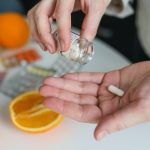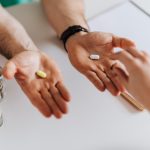List Of Drugs That Can Cause Commotio Cordis

Commotio cordis is a rare, but potentially lethal condition that occurs as a result of a sudden blow to the chest, usually during sports activities. The term “commotio cordis” literally means “agitation of the heart” and it refers to a disruption in the normal rhythm of the heart that can cause sudden cardiac arrest.
When a person is struck in the chest, the impact can cause a sudden and severe disruption to the electrical activity of the heart. This disruption can lead to a condition called ventricular fibrillation, where the heart muscle contracts in a rapid and chaotic manner, rather than in a coordinated way. This irregular contraction can prevent the heart from pumping blood effectively, which can lead to sudden cardiac arrest and even death if not treated immediately.
Commotio cordis most commonly occurs in young males who are involved in sports such as baseball, hockey, or lacrosse, where a hard object, such as a ball or puck, can strike the chest at high velocity. The risk of commotio cordis is highest in children between the ages of 10 and 18, and the incidence of the condition tends to be higher in the spring and summer months when outdoor sports are more common.
Symptoms of commotio cordis can include sudden collapse, loss of consciousness, and cessation of breathing. In many cases, the victim may not display any symptoms before collapsing. Commotio cordis requires immediate medical attention, including the use of a defibrillator to restore the heart’s normal rhythm. If treatment is not initiated promptly, commotio cordis can quickly lead to irreversible brain damage or death. In this article, we will take an in-depth look at drugs that can cause or increase the risk of commotio cordis.
List Of Drugs That Can Cause Commotio Cordis
There are certain medications may increase the risk of heart arrhythmias, which could potentially contribute to the development of commotio cordis in susceptible individuals. These medications include:
Antiarrhythmic medications
Antiarrhythmic medications are used to treat abnormal heart rhythms, but they have also been associated with an increased risk of arrhythmias, which could potentially contribute to the development of commotio cordis in susceptible individuals.
For example, drugs like amiodarone, quinidine, and sotalol can cause ventricular arrhythmias, including torsades de pointes, which is a rare but potentially life-threatening arrhythmia. If torsades de pointes degenerates into ventricular fibrillation, it could potentially cause commotio cordis.
Beta-blockers
Beta-blockers are a type of medication that is commonly used to treat high blood pressure, heart failure, and certain heart rhythm disorders. While beta-blockers are generally safe and effective, they have been associated with an increased risk of arrhythmias, which could potentially contribute to the development of commotio cordis in susceptible individuals.
Beta-blockers work by blocking the action of adrenaline on the heart, which can slow the heart rate and reduce the force of contraction. However, in some cases, beta blockers can also cause bradycardia (a slow heart rate) or other heart rhythm disturbances, which could potentially lead to the development of commotio cordis if the individual experiences a sudden impact on the chest.
Calcium channel blockers
Calcium channel blockers are a class of medications commonly used to treat high blood pressure, angina (chest pain), and certain heart rhythm disorders. While these medications are generally safe and effective, they have been associated with an increased risk of arrhythmias, which could potentially contribute to the development of commotio cordis in susceptible individuals.
Calcium channel blockers work by blocking the flow of calcium ions into the heart muscle cells, which can relax blood vessels and reduce the workload on the heart. However, in some cases, calcium channel blockers can also affect the heart’s electrical system, which could potentially lead to the development of arrhythmias and, in rare cases, commotio cordis if the individual experiences a sudden impact to the chest.
Antibiotics
While antibiotics are not directly associated with the development of commotio cordis, some antibiotics can cause cardiac side effects that may increase the risk of arrhythmias, which could potentially contribute to the development of commotio cordis in susceptible individuals.
For example, antibiotics like erythromycin and clarithromycin have been associated with an increased risk of QT interval prolongation, which is a heart rhythm disturbance that can lead to torsades de pointes, a rare but potentially life-threatening arrhythmia. If torsades de pointes degenerates into ventricular fibrillation, it could potentially cause commotio cordis.
Antipsychotic medications
Antipsychotic medications are used to treat mental health disorders such as schizophrenia and bipolar disorder. While these medications are generally safe and effective, they have been associated with an increased risk of arrhythmias, which could potentially contribute to the development of commotio cordis in susceptible individuals.
Antipsychotic medications can cause QT interval prolongation, which is a heart rhythm disturbance that can lead to torsades de pointes, a rare but potentially life-threatening arrhythmia. If torsades de pointes degenerates into ventricular fibrillation, it could potentially cause commotio cordis.
It’s important to note that the risk of commotio cordis associated with the above-listed medications is relatively rare and only occurs in certain individuals who have underlying heart conditions or who are taking medications inappropriately. Patients who are prescribed medications should be closely monitored by their healthcare provider for potential side effects and complications. If a patient experiences any unusual symptoms or side effects, they should seek medical attention immediately.
How to Prevent Drug-induced Commotio Cordis
While drug-induced commotio cordis is relatively rare, there are some steps that can be taken to prevent this potentially life-threatening condition:
1. Use medications as directed: Follow your healthcare provider’s instructions when taking medications. Take medications at the recommended dose and frequency, and do not skip or double up on doses without consulting your healthcare provider.
2. Inform your healthcare provider of any pre-existing heart conditions: If you have a history of heart disease or arrhythmias, inform your healthcare provider before starting any new medications. Your healthcare provider can help you determine if a medication is safe for you to take, and can monitor you closely for any potential side effects.
3. Avoid illicit drug use: Illicit drugs can cause a wide range of cardiac side effects, including arrhythmias that could potentially contribute to the development of commotio cordis. Avoiding illicit drugs can help reduce the risk of drug-induced commotio cordis.
4. Regularly monitor cardiac function: If you are taking medications that have been associated with an increased risk of arrhythmias, your healthcare provider may recommend regular cardiac monitoring to ensure that your heart function remains stable. This may include electrocardiograms (ECGs) or other diagnostic tests.
5. Seek medical attention if you experience unusual symptoms: If you experience any unusual symptoms, such as chest pain, shortness of breath, palpitations, or dizziness, seek medical attention immediately. These symptoms could be indicative of an underlying heart condition or a medication-related side effect that could potentially contribute to the development of commotio cordis.





